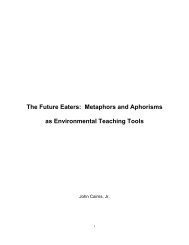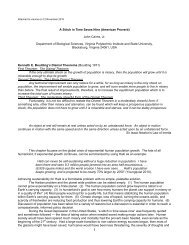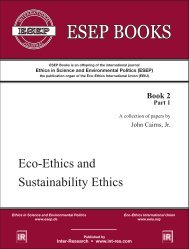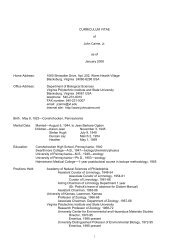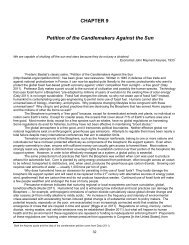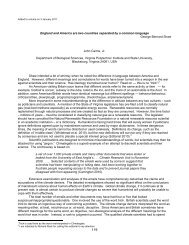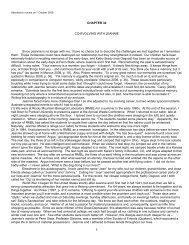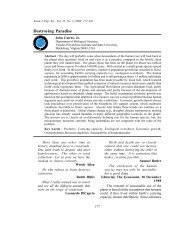View - ResearchGate
View - ResearchGate
View - ResearchGate
You also want an ePaper? Increase the reach of your titles
YUMPU automatically turns print PDFs into web optimized ePapers that Google loves.
Article 37319to 1.5 hectares (Wackernagel & Rees 1996). The fossil energy use (in gigajoules/year) was 287 perperson per year (in 1991) and 5 per person per year (in 1991) for India (Wackernagel & Rees 1996,p. 85). One might well ask if greatly disproportionate use of Earth’s resources is elitist. Some questionsmust be answered if immigrants are allowed to get aboard an ecological ‘lifeboat.’ Over half theworld’s population is living on US$3 per day or less (the latest figures are always available from theUN). If as many as 1 billion individuals wish to immigrate to a more affluent country, such as the US,Canada, and Australia, many aspects of this immigration must be considered. Which of the one billionshould be admitted? Should entrance be ‘first come, first served’? Should entrance be based onneed? How is any distinction handled and what is said to those who are excluded? A more detaileddiscussion of these issues can be found in Hardin (2001).The dramatic novel of Raspail (1973) has often been cited to support the view that ‘restricting thepoor and miserable will not maintain or increase the overall well being of the planet and its biosphere.’However, the main point of the novel is the consequences of the citizens of the impoverishedcountries attempting to get the wealthy nations to share more of the world’s resources. Onefactor is very clear — Earth is a finite planet with finite resources and neither is infinitely expandable.Reaching population stabilization is an extremely complex issue that is not likely to be resolved ina single publication. However, taking more resources from the 30+ million other species with whichhumankind shares the planet is neither ecologically nor ethically sound.As noted elsewhere in this journal, I advocate positive action to stabilize world population andensure a fair and equitable distribution of resources. 15 These and other publications in ESEPrecommend that wealthy nations assist less affluent countries in stabilization, as well as endorsinga fair and equitable distribution of resources. If the more affluent countries reduced the size of theirecological footprints and set an example by living sustainably, the world would have models tofollow and more resources would be available to help other countries achieve sustainability.CONCLUSIONSReducing catastrophes resulting from human activities is essential to sustainable use of theplanet. Most societies are now sufficiently large, relative to their resource base, to preclude individualsfrom exercising complete control over their own destiny. Nation-states determine the fateof humankind. Thomas Jefferson’s 1781 book Notes on Virginia warned of the dangers of importingpeoples not literate in ‘the freest principles of the English Constitution with others derived fromnatural right and natural reason.’Catastrophes, resource wars, and political refugees will all probably increase (in rate, number,and severity) as humankind encounters resource limits. This statement then leads to coupling scientificknowledge with ecological and sustainability ethics as humankind addresses the centralissue — population size and the natural resource base needed to support it cannot be separated.Migration of humans, including immigration, is generally viewed as an ethical issue, but there is astrong interconnection between human population size, both globally and locally, and the size andhealth of the natural resource base.The fundamental issue of human survival (sustainable use of the planet) is how to develop a harmoniousrelationship between humankind and natural systems. Until this relationship develops,15 See Cairns J Jr (2004) Allocating finite resources on a finite planet. ESEP 2004:25–27, available online athttp://www.esep.de/articles/esep/2004/E47.pdf; Cairns J Jr (2004) You and Earth’s resources. ESEP2004:9–11, available online at http://www.esep.de/articles/esep/2004/E45.pdf



